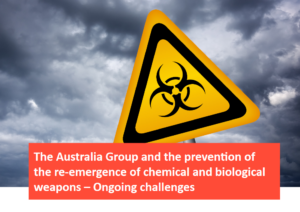The Australia Group and the prevention of the re-emergence of chemical and biological weapons
The European Union Non-Proliferation and Disarmament Consortium held its 11th Consultative Meeting in Brussels on 15 and 16 September 2022. Its central theme was the “Topicality of multilateral export control regimes”. On the second day, one of the four breakout sessions addressed the Australia Group, an informal arrangement coordinating technology transfer controls relating to dual-use agents and equipment with potential relevance for developing and producing chemical and biological weapons.
 Introducers were Ms Esmée de Bruin (Netherlands), Dr Mónica Chinchilla (Spain) and Ms Élisande Nexon, PharmD (France). I had the honour of moderating the session.
Introducers were Ms Esmée de Bruin (Netherlands), Dr Mónica Chinchilla (Spain) and Ms Élisande Nexon, PharmD (France). I had the honour of moderating the session.
The three speakers have different backgrounds, thus giving the session a distinct multidisciplinary flavour. Ms de Bruin, focusing on the effectiveness of export control regimes in general, approached the Australia Group from economic and international law angles. Dr Chinchilla, an expert in international law, saw in the practice of the Australia Group the emergence of soft law complementing the Chemical Weapons Convention (CWC), a near-universal global disarmament treaty. Ms Nexon, a Doctor of Pharmacy with expertise in biosecurity and biosafety and arms control and disarmament, addressed challenges to the Biological and Toxin Weapons Convention (BTWC) posed by the rapid advances in life sciences and biotechnology industries and how the Australia Group can help mitigating possible security risks. Their introductions engaged the approximately twenty session participants in rich discussions.
The present publication by the Fondation pour la recherche stratégique is the direct result of this breakout session. The different angles to the analysis of the Australia Group with reference to the BTWC and the CWC revealed interesting viewpoints about how an informal arrangement relates to formal and quasi-universal treaties comprehensively banning two discrete weapon categories. Other export control arrangements are either standalone initiatives (e.g. the Missile Technology Control Regime or the Wassenaar Arrangement) or, in the case of the Nuclear Suppliers Group, linked to a non-proliferation rather than disarmament treaty. One of the central questions that came to the fore was whether to try and achieve greater integration and coordination among the four export control arrangements. If so, how might this intent affect the Australia Group that had adjusted its mission to support both global disarmament treaties? The BTWC and the CWC each have an article on international cooperation, development and scientific and technology exchanges for peaceful purposes. During the 1990s and 2000s, many developing countries came to view the Australia Group’s activities as incompatible with the disarmament objectives.
The chapters in this publication are not the presentations made in September 2022. Instead, the authors reviewed their introductions in light of the discussions. They addressed how the Australia Group blends with the broader practice of responsible trade in dual-use commodities to prevent weapon proliferation while supporting the core disarmament goals of the BTWC and the CWC. The question relates to regime development, which in turn implies how the Australia Group can address challenges to its internal decision-making, future objectives and the ambition of global standard-setting concerning the adaptability of both conventions to emerging issues, on the one hand, and the work and experiences of the other export control arrangements given convergences in security matters, on the other hand.
An introductory chapter sets the stage for this discussion by describing the origin of the Australia Group, how its practices evolved, and how with the end of the Cold War the recasting of weapon control problems in terms of proliferation affected the CWC during the negotiation end game and its early implementation.
Jean Pascal Zanders (Ed.), The Australia Group and the prevention of the re-emergence of chemical and biological weapons – Ongoing challenges, Fondation pour la recherche stratégique (Paris, April 2024), 54p. (PDF file)
